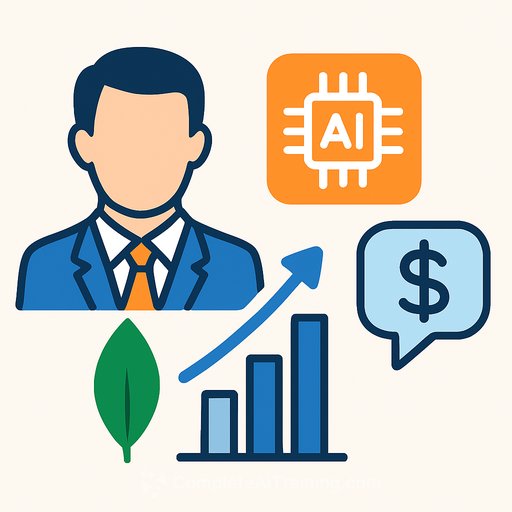MongoDB's AI Strategy and New Leadership: What Executives Should Do Next
MongoDB's consensus analyst price target ticked up from $353.37 to $369.91. It's a modest move, but the signal is clear: stronger operations, a tighter AI story, and rising confidence after a leadership transition.
For leaders planning budgets, platforms, and AI delivery, the message is practical: watch Atlas momentum, test the new modernization stack, and set guardrails on cost and time-to-value. Here's the rundown and the moves that matter.
What Wall Street Is Signaling
- Price targets were lifted by several firms: BofA to $440, Citizens JMP to $435, DA Davidson to $415, and Wedbush to $400. Wells Fargo initiated with Overweight and a $430 target; Wedbush added the stock to its Best Ideas List.
- Positive themes: Atlas growth, execution quality, larger enterprise wins, and AI-related use cases (including agentic coding efficiency) driving the next leg.
- Analysts citing traction and transparency include BMO Capital, Cantor Fitzgerald, Morgan Stanley, Oppenheimer, Wolfe Research, and Piper Sandler.
- Key caveat from bulls: valuation. Barclays also flags that "broad" new financial targets could cap near-term upside.
Where the Bears Push Back
- Valuation risk: UBS holds Neutral despite lifting targets (to $330 and $310 at different times), suggesting upside may be priced in.
- Competition and timing: Scotiabank notes pressure from PostgreSQL and uncertainty around the timing/scale of AI benefits; maintains Sector Perform.
- Barclays echoes that wide target ranges may restrain immediate share gains even with a solid fundamental outlook.
Leadership and Strategy Moves to Watch
Chirantan "CJ" Desai is in as CEO effective November 10, 2025. Dev Ittycheria moves to an advisory role to support a steady handover.
Expect sharper enterprise focus and continued platform expansion under new leadership. Track the first 100 days for org design changes, pricing signals, and AI product cadence. For official updates, bookmark MongoDB's investor site.
Product and GTM: AI + Application Modernization
MongoDB introduced the AI-powered MongoDB AMP (Application Modernization Platform). The claim: modernize legacy apps 2-3x faster. If execution matches the pitch, this compresses migration timelines and can shift multi-year programs forward.
Atlas remains the growth engine. Pair that with agentic coding and you get a push toward faster build cycles, but also the need for tighter cost governance as workloads scale.
Capital Allocation and Guidance
- Q3 FY26 revenue now guided to $587-$592 million.
- Full-year revenue outlook: $2.34-$2.36 billion.
- Share repurchases: 929,674 shares for $200.68 million (1.14%). This suggests confidence in intrinsic value and adds a small tailwind to per-share metrics.
Fair Value Inputs Shifted (What That Implies)
- Consensus price target: $353.37 ➝ $369.91
- Discount rate: 8.86% ➝ 8.85% (slightly lower perceived risk)
- Revenue growth projection: 16.95% ➝ 17.11%
- Net profit margin: 35.93% ➝ 39.80%
- Future P/E: 3540.16x ➝ 3330.24x (expectations now point to higher earnings vs. price)
Executive Playbook: Concrete Moves for the Next Two Quarters
- Modernization pilot: Pick one high-impact legacy app and run a 60-90 day pilot with AMP. Define a target unit cost, SLOs, and an explicit "stop/scale" threshold.
- Data strategy refresh: Map AI use cases to data models and latency demands. Decide where Atlas fits vs. existing databases. Eliminate redundant stores.
- FinOps guardrails: Lock in workload budgets per environment. Tie agentic coding output to cost per feature and defect rates.
- Vendor posture: If you're already on MongoDB, negotiate scalability tiers and AI roadmap access. If you're standardized on PostgreSQL, clarify coexistence, migration criteria, and exit plans.
- Security and compliance: Pre-bake patterns for PII handling, audit trails, and lineage for AI-enabled features. Make this a gate, not an afterthought.
- Talent and delivery: Upskill architects and platform teams on modern data patterns and AI-driven development flows. If you need a structured path, consider role-based programs for engineers and product leaders.
- KPIs that matter: time-to-first-value on modernization, cost per 1,000 reads/writes per region, AI feature adoption, bug rate post-release, and gross margin impact.
Practical AI learning paths by job role can help standardize training and shorten ramp time.
Risks and Watchpoints
- Valuation sensitivity: execution slip-ups can hit richly valued names harder.
- AI payoff timing: productivity gains don't always convert to revenue right away.
- Workload economics: poorly scoped AI features can bloat costs quickly.
- Open-source pressure: PostgreSQL and adjacent stacks can undercut with TCO and flexibility narratives.
- Guidance breadth: wide targets may limit near-term rerating until evidence tightens.
What to Track Next
- CEO CJ Desai's first 100-day moves and any org/pricing changes.
- Atlas growth, mix, and large-deal momentum tied to AI use cases.
- AMP adoption: reference customers, time-to-migrate, and cost outcomes.
- Margin trajectory vs. rising AI workloads.
- Competitive wins/losses vs. PostgreSQL in core enterprise accounts.
Bottom line: leadership is stable, AI is becoming a revenue story (not just a slide), and the Street is warming-tempered by valuation. Run a focused pilot, measure unit economics, and scale with discipline.
Note: This commentary is informational and not financial advice. Always align decisions with your strategy, risk tolerance, and internal data.
Your membership also unlocks:






